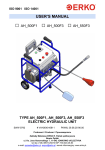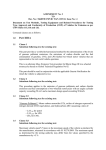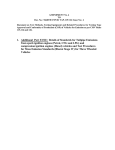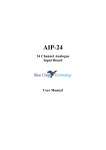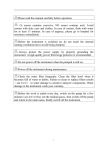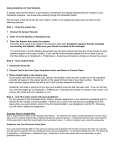Download CHAPTER II: TECHNICAL SPECIFICATIONS AND TEST
Transcript
CHAPTER II: TECHNICAL SPECIFICATIONS AND TEST PROCEDURE FOR TYPE APPROVAL OF 2 GAS ANALYSER 1 SCOPE AND FIELD OF APPLICATION This standard lays down technical specification for the analyser equipment used for the determination of concentration of exhaust carbon monoxide (CO) and Hydro carbon (HC) emissions from road vehicles equipped with the spark ignition engines. The type approval of the CO part of the 2 gas analyzer shall be carried out as per the test procedure given below. The HC part of the 2 gas analyzer shall be tested as per Annexure-I to this chapter. 2 REFERENCE ISO 3930, 1976. 3 PERFORMANCE CRITERIA 3.1 Analyser Accuracy The CO analyser shall have an accuracy of ± 3% of full scale as determined by analysing known standard gases. This accuracy of ± 3% of full scale shall be checked with the calibration gases of known concentration at minimum five points covering zero to full scale range. Calibration points shall be uniformly spaced as far as possible. It is preferred to test at ten points with five points below 5% of CO. 3.2 Interference effects The sum of the individual effects on the reading of the analyser from other gases and particularly in concentration closed to those existing in the engine exhaust gas shall be less than 0.2 units. Interference of Carbon-di-oxide (CO2) and water shall be checked with CO2 gas between 12 to 16% concentration by flowing : a) b) c) d) Only CO2 gas; CO2 gas bubbled through water; Nitrogen bubbled through water; CO bubbled through water; or known mixture of above all gases. 3.3 System Response Time 3.4 The analyser concentration indication shall reach 90% of the final stabilised reading within 10 seconds after a step change in concentration level initiated at the sample probe inlet. Drift MoRTH / CMVR / TAP-115/116 (Issue 4) Page 239 Zero and span drift of a warm up instrument shall not be greater than ± 3% of full scale during one hour of operation. This test shall be conducted by passing a span gas having concentration more than 60% of the full scale. 3.5 Repeatability Analyser repeatability shall be within ± 2% of full scale during five successive samples of the same gas source. This test shall be conducted by passing a span gas having concentration more than 60% of the full scale. 3.6 Warm up Time Unless otherwise indicated on the instrument, the analyser shall reach stabilised operation within 30 minutes from 'power on'. 3.7 Span The instrument shall have the capability of being spanned using both calibration gas bottles and electromechanical or electronic methods. For the instruments having automatic zero and span adjustments, its equivalence to the electromechanical or electronic methods has to be established by the manufacturer. ⌦ If the instrument does not have the facility to check and adjust the span calibration by electronic or electromechanical means, the manufacturer shall prove that the span calibration by the means of calibration gas remains stable with time, ambient temperature, barometric pressure, aging of IR source, aging of IR detector, aging of the electronic components and other relevant parameters manufacturer, whichever is higher. The manufacturer shall provide the supporting data and documents to prove the stability. ⌦ The instrument shall have a suitable provision for connection to the pressurized 10 / 47 litre gas cylinders by the means of 1/4" Teflon tube and compression tube fitting. 3.8 Sample Handling System The sample handling materials that are in contact with the gas sample shall not contaminate or change the character of the gases to be analysed. All sampling system internal surfaces shall be corrosion resistant to motor vehicle exhaust gases. The sample handling system shall provide for particulate and water removal as required to prevent these contaminants from affecting gas analysis. The filtering and water removal components shall be designed for easy maintenance. ⌦ The instrument shall have provision of testing the leak into the complete sample handling system including probe. This can be provided by means of vacuum switch with closing cap on the probe or through the flow indicator with closing cap or any other means. The vacuum switch setting or the flow meter MoRTH / CMVR / TAP-115/116 (Issue 4) Page 240 range shall be designed so that any small leakage, which affects the readings, can be detected. 3.9 Safety requirements The construction, materials and electrical systems used in the instrument system shall comply with local provisions. Each analyser system shall be constructed and shall incorporate safety devices for protection of the personnel and nearby equipment. 3.10 Temperature Sensitivity The instrument shall be suitable for ambient temperatures between 278 K and 318 K. Between these two limits the result of the measurement shall not differ from that obtained at a temperature of 303 K ( ± 2 K) by more than 0.2 units. This test shall be conducted by passing a span gas having concentration more than 60% of the full scale. This test shall be conducted in the temperature controlled chamber and readings shall be taken after allowing two hours stabilisation time after attaining specified temperature. Any other drift like zero drift/span drift with time (if observed) shall be compensated for this time interval. 4.0 DESIGN CHARACTERISTICS 4.1 Instrument construction The instrument shall be designed and constructed to provide reliable and accurate service in the motor vehicle repair garage environment. 4.1.1 Mobility The instrument may be permanently mounted, portable or mobile. 4.1.2 Identification The identification of the instrument shall be permanently attached to the outer surface of the analyser enclosure. The identification shall include the model and serial number, name and address of the instrument manufacturer, production date, electrical power requirements and operating voltage range. 4.1.3 Electrical design Analyser operation shall be unaffected by an electrical voltage variation of 230 V ± 10%. The instruments powered by battery shall have battery condition indication and the battery voltage shall be varied within the indicated range. 4.1.4 Controls MoRTH / CMVR / TAP-115/116 (Issue 4) Page 241 The span and zero controls shall be readily accessible but protected against accidental misadjustment. 4.1.5 Electromagnetic Isolation The instrument shall be capable of providing unaffected operation in electromagnetic radiation or conductive interference produced by vehicle ignition systems and building electrical systems. This test shall be conducted in the vicinity of minimum five number of SI engine vehicles operating within approximate distance of 3 to 5 metres from the equipment. The vehicles shall not be fitted with ignition suppression devices. 4.1.6 Vibration Test The system operation shall be unaffected by the vibration and shock encountered under the normal operating conditions in the motor vehicle repair garage. Vibration test shall be conducted as per IS 9000 Part VIII 1981. Analyser may be subjected to vibration in normal mounting axis for 5 to 9 Hz ± 3 mm displacement and 9 to 150 Hz ± g acceleration amplitude, preferably with electrical power 'ON' condition. The span reading with span gas having concentration more than 60 % of full scale, before and after the test, shall not differ by more than 1 % of full scale.Any other drift like zero drift/ span drift with time (if observed) shall be compensated. 4.1.7 Drop Test The meter components (except those which are wall mounted) shall be positioned in their normal orientation of use on a rigid surface. They shall be tilted on one bottom edge and then allowed to fall freely on to the test surface. All covers shall be fitted properly. They shall be subjected to two falls on each edge from a height of 50 mm, measured from the elevated edge of the unit to the test surface. As the electrical power is switched off, the instrument shall be warmed up and initial electronic calibration shall be carried out. The span reading with span gas having concentration more than 60 % of full scale, before and after the test, shall not differ by more than 1 % of full scale. 4.1.8 Operating Instructions Concise operating instructions including the calibration procedures and instrument calibration curves shall be supplied by the manufacturers with the instrument. The manufacturer shall supply following information for certification : a) Detailed specifications of the equipment along with standard accessories/standard fittments. MoRTH / CMVR / TAP-115/116 (Issue 4) Page 242 ⌦ b) The operating manual supplied with every CO analyser shall include the description of the test procedure described in Part-I of the document MOST/CMVR/TAP-115/116 (Details of Standards and Test Procedures for Carbon Monoxide Emissions at idling for In-service vehicles fitted with Petrol Engines). The manual shall also specify the recommended calibration interval. c) Service manual. d) Flow schematic diagrams. e) Details of sample handling system material. f) Photograph of the instrument. 4.2 Sampling System The vehicle exhaust gas sampling system shall consist of an exhaust pipe probe and an analysis system and may include a water removal system and/or filter(s). The sampling line shall be a minimum of three meters in length. 4.2.1 Probe The probe design shall be such that it will not slip out of the motor vehicle exhaust pipe when in use for analysis. A thermally insulated comfortable hand grip shall be provided on the sample probe handle. The probe shall be flexible enough to extend into the tailpipe atleast 300 mm. ⌦ Every CO analyser shall also be supplied with an exhaust extension pipe as a standard accessory. The extension pipe connection shall be universally adaptable to the exhaust pipe of all petrol engine vehicles. 4.2.2 Water Removal System If a water removal system is required to remove vehicle exhaust gas water vapour from the sample gas, prior to its entering the instrument analyser, the collection vessel shall be visible to the operator and a draining provision shall be provided. 4.3 Analytical System The accuracy, system response time, drift, repeatability, warm up time shall be as specified in the performance criteria. 4.3.1 Instrument Range The instrument full scale range shall be between 8 to 10 % of CO. 4.3.2 Span Techniques The instrument system shall have provision for adjustment of zero and span setting by calibration gas. A second type of span adjustment may be provided for electromechanical, electrical, electronic or other acceptable method. MoRTH / CMVR / TAP-115/116 (Issue 4) Page 243 If the instrument is not self-compensated for non-standard conditions of altitude and ambient temperatures or not equipped with a manually controlled system of compensation, the scale calibration shall be performed using calibration gas. The carrier gas shall be dry nitrogen. The accuracy of the shall be within ± 2 % of the concentration stated. 5.0 span gas blends Instruments with facility for carbon-di-oxide measurement shall meet all the above performance criteria mentioned for CO analysers, except that the instrument read-out shall have a range of 0 to 20 % or less. ⌦ 6.0 The instrument shall be provided with a printer. It shall print the CO reading in English when tested as per the procedure followed for CMVR 115 (2) a and b. The printer shall also print the date and time of the test. A software provision shall be made so that maximum of two print outs can be taken for each test. A facility to print the CO reading after calibration along with the date and time of calibration shall also be provided. MoRTH / CMVR / TAP-115/116 (Issue 4) Page 244 ANNEXURE-I TECHNICAL SPECIFICATION AND TEST PROCEDURE FOR HC PART OF PRESENT 2 GAS ANALYSER 1. Instrument range and resolution The instrument full-scale range for HC measurement shall be 10,000 ppm with resolution of at least 10 ppm. 2. Propane/hexane equivalency factor The content of hydrocarbons shall be expressed in ppm vol n-hexane (C6 H14 ) equivalent. The adjustment may be carried out using propane (C3 H8 ). Therefore, a conversion factor referred to as “C3 /C6 Equivalence Factor”, or PEF, shall be permanently and conspicuously marked or easily displayed on each instrument. Alternatively, display of an array of conversion factors is allowed provided that the associated volume fractions are also displayed. The manufacturer shall provide the conversion factor(s) for each individual instrument to three significant figures. If the gas-sensitive element is replaced or repaired, the new conversion factor(s) shall be attached to the Instrument. 3.0 PERFORMANCE CRITERIA 3.1 Analyser Accuracy The HC part of 2-Gas analyser shall have an accuracy of ± 30 ppm absolute or + 10% relative, whichever is greater determined by analysing known standard gases. This accuracy shall be checked with the calibration gases of known concentration at minimum five points covering zero to full-scale range. Calibration points shall be uniformly spaced as far as possible. It is preferred to test at ten points with five points below 5000 ppm of HC. 2.2 Interference effects The sum of the individual effects on the reading of the analyser from other gases and perticularly in concentration closed to those existing in the engine exhaust gas shall be less than 15 ppm. Interference of Carbon dioxide (CO2) and water shall be checked with CO2 gas between 12 to 16% concentration by following : a) b) c) d) 2.3 Only CO2 gas; CO2 gas bubbled through water; Nitrogen bubbled through water; CO bubbled through water or known mixture of above all gases System Response Time MoRTH / CMVR / TAP-115/116 (Issue 4) Page 245 The analyser concentration indication shall reach 90% of the final stabilised reading within 10 seconds after a step change in concentration level initiated at the sample probe inlet. 2.4 Drift Zero and span drift of a warmed up instrument shall not be greater than ± 30 ppm absolute or + 10% relative, whichever is greater during one hour of operation. This test shall be conducted by passing a span gas having concentration more than 60% of the full scale. 2.5 Repeatability Analyser repeatability shall be within ± 30 ppm absolute or + 10% relative, whichever is greater during five successive samples of the same gas source. This test shall be conducted by passing a span gas having concentration more than 60% of the full scale. 2.6 Temperature Sensitivity The instrument shall be suitable for operation at ambient temperatures between 278 K and 318 K. Between these two limits the result of the measurement shall not differ from that obtained at a temperature of 303 K ( ± 2 K) by more than ± 30 ppm absolute or + 10% relative ,whichever is greater This test shall be conducted by passing a span gas having concentration more than 60% of the full scale. This test shall be conducted in the temperature controlled chamber and readings shall be taken after allowing two hours stabilisation time after attaining specified temperature. Any other drift like zero drift/span drift with time (if observed) shall be compensated for this time interval. ******** MoRTH / CMVR / TAP-115/116 (Issue 4) Page 246








